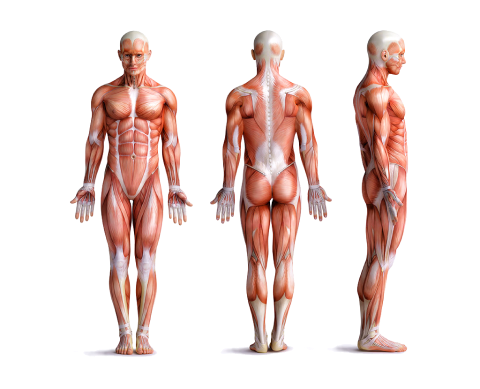As a personal trainer, you must be confident in using terminology correctly so you can communicate with clients, colleagues, and other health professionals. Anatomical terms give you the language necessary to describe the functions, relationships, and purposes of anatomy and physiology.
In other words, knowing anatomical and physiological vocabulary helps you understand the body.
In this topic, you will learn:
- Anatomical position
- Directional terms
- Body planes and sections
- Movement terms
- Body cavities
- Homeostasis
- Human body systems

What is "Anatomy and Physiology"?
Studying two branches of science, anatomy and physiology, provides the foundation of knowledge of the body's parts and functions.
Anatomy is the study of the body's structures or parts. It asks...
What is that? And where is it in the body?
Physiology is the study of the functions of body parts. It asks...
What does it do?
Anatomy and physiology focus on different aspects of the study of the body, but they are typically studied together because the structure (anatomy) and function (physiology) of the body are closely related.
Structure mirrors function
As you progress with your anatomy and physiology studies, remember that structure mirrors function. Doing so will give you a deeper understanding of why and how something works, including:
- how and why muscles and joints move in particular ways.
- how organs function.
- how organs work together (organ systems).
- how the body works in sickness and in health.
Terminology checkpoint
Homeostasis is the reason why the body does what it does, when it does it, and how it adapts to finding new ways to continue doing what it does.
It is responsible for maintaining balance and equilibrium in the body as a whole.
Homeostasis is the condition of equilibrium of the body’s internal environment due to the constant interaction of the body’s many regulatory processes, and changing external environment.
Homeostasis is a dynamic condition which means it never sleeps. It constantly works to maintain our internal environment in its 'optimal' or most functional state.
Homeostasis can be defined as:
maintaining the body’s internal environment, in response to changing conditions, within normal bodily limits.
Body temperature
Let's look at body temperature as an example of how homeostasis works.
Normal body temperature ranges from 36.5 to 37.5 degrees Celsius, with a fever setting in at approximately 37.6 degrees. This shows us the very small window of one degree that the body and the relevant systems coordinate to maintain.
If you have ever had a fever, you will know how uncomfortable you felt! In some cases, patients are admitted to the hospital. Mild and moderate fevers cause weakness and exhaustion. A very high fever (40 degrees or higher) can result in convulsions and death. This is just one example of factors within the body that is constantly under review and stabilised. This is like a continuous, 24/7 risk analysis project management of our bodies!
Environmental impacts
Homeostasis is constantly being challenged and disturbed every second of every day. Consider the following two situations.
- You take a walk outside where it is warm, and you become out of breath and inhale the air from the surrounding environment.
- In another situation, you are sitting at your desk, slouched over, tired, with dry eyes.
How does your body react to different environments?
Every moment of the day and night your body and its systems are constantly:
- surveying the body's internal systems.
- communicating with other cells and systems of the body to let them know what is happening.
- recruiting additional cellular or system-based support when it is needed.
There are 11 systems in the human body. The systems work independently of each other, but if one is not functioning as intended, the others will try to correct the problem. The systems work together to maintain homeostasis.
Main systems of the human body:
- Cardiovascular
- Digestive
- Endocrine
- Integumentary
- Lymphatic
- Muscular
- Nervous
- Reproductive
- Respiratory
- Skeletal
- Urinary

Human Body Systems by OpenMD.com, © OpenMD.com
